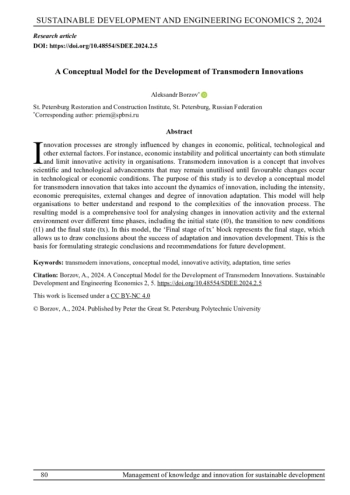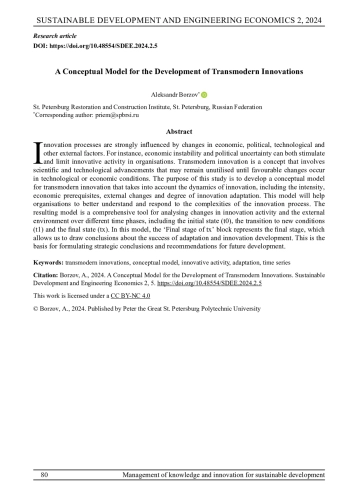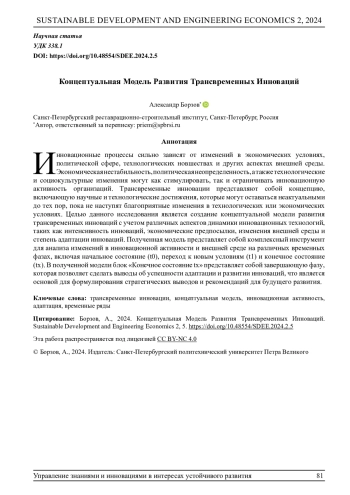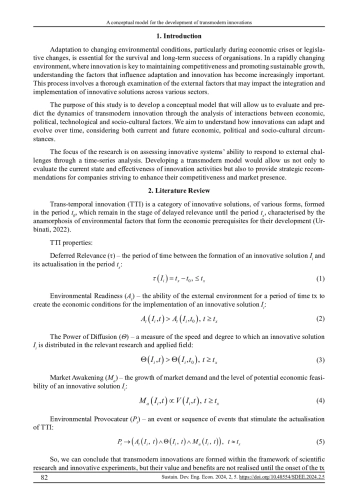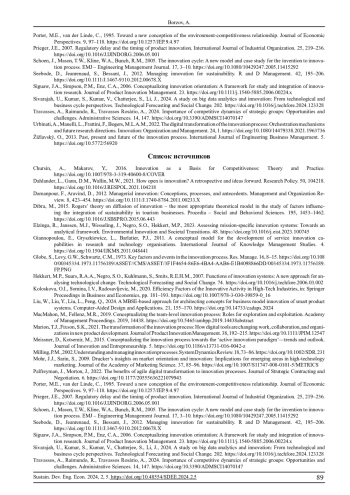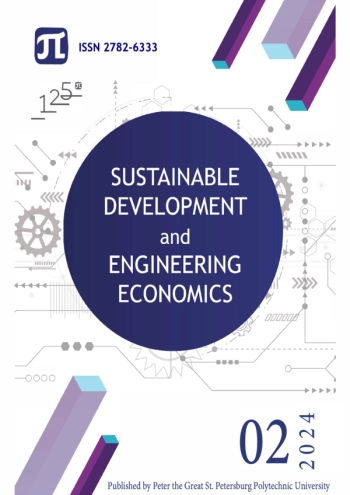Innovation processes are strongly in uenced by changes in economic, political, technological and other external factors. For instance, economic instability and political uncertainty can both stimulate and limit innovative activity in organisations. Transmodern innovation is a concept that involves scienti c and technological advancements that may remain unutilised until favourable changes occur in technological or economic conditions. The purpose of this study is to develop a conceptual model for transmodern innovation that takes into account the dynamics of innovation, including the intensity, economic prerequisites, external changes and degree of innovation adaptation. This model will help organisations to better understand and respond to the complexities of the innovation process. The resulting model is a comprehensive tool for analysing changes in innovation activity and the external environment over di erent time phases, including the initial state (t0), the transition to new conditions (t1) and the nal state (tx). In this model, the ‘Final stage of tx’ block represents the nal stage, which allows us to draw conclusions about the success of adaptation and innovation development. This is the basis for formulating strategic conclusions and recommendations for future development.
Идентификаторы и классификаторы
Adaptation to changing environmental conditions, particularly during economic crises or legislative changes, is essential for the survival and long-term success of organisations. In a rapidly changing environment, where innovation is key to maintaining competitiveness and promoting sustainable growth, understanding the factors that influence adaptation and innovation has become increasingly important. This process involves a thorough examination of the external factors that may impact the integration and implementation of innovative solutions across various sectors.
Список литературы
1. Chursin, A., Makarov, Y., 2016. Innovation as a Basis for Competitiveness: Theory and Practice. DOI: 10.1007/978-3-319-40600-8/COVER EDN: YUWFBR
2. Dahlander, L., Gann, D.M., Wallin, M.W., 2021. How open is innovation? A retrospective and ideas forward. Research Policy. 50, 104218. DOI: 10.1016/J.RESPOL.2021.104218 EDN: LGUZMV
3. Damanpour, F., Aravind, D., 2012. Managerial innovation: Conceptions, processes, and antecedents. Management and Organization Review. 8, 423-454. DOI: 10.1111/J.1740-8784.2011.00233.X
4. Dibra, M., 2015. Rogers’ theory on diffusion of innovation - the most appropriate theoretical model in the study of factors influencing the integration of sustainability in tourism businesses. Procedia - Social and Behavioral Sciences. 195, 1453-1462. DOI: 10.1016/J.SBSPRO.2015.06.443
5. Elzinga, R., Janssen, M.J., Wesseling, J., Negro, S.O., Hekkert, M.P., 2023. Assessing mission-specific innovation systems: Towards an analytical framework. Environmental Innovation and Societal Transitions. 48. DOI: 10.1016/j.eist.2023.100745
6. Giannopoulou, E., Gryszkiewicz, L., Barlatier, P.J., 2011. A conceptual model for the development of service innovation capabilities in research and technology organisations. International Journal of Knowledge Management Studies. 4. DOI: 10.1504/IJKMS.2011.048441
7. Globe, S., Levy, G.W., Schwartz, C.M., 1973. Key factors and events in the innovation process. Res. Manage. 16, 8-15. //CMS/ASSET/3F1F4654-86E6-4BA4-AAB6-E1B4098866DD/00345334.1973.11756189.FP.PNG. DOI: 10.1080/00345334.1973.11756189/ASSET
8. Hekkert, M.P., Suurs, R.A.A., Negro, S.O., Kuhlmann, S., Smits, R.E.H.M., 2007. Functions of innovation systems: A new approach for analysing technological change. Technological Forecasting and Social Change. 74. DOI: 10.1016/j.techfore.2006.03.002
9. Koloskova, O.I., Somina, I.V., Radosavljevic, M., 2020. Efficiency Factors of the Innovative Activity in High-Tech Industries, in: Springer Proceedings in Business and Economics, pp. 181-193. DOI: 10.1007/978-3-030-39859-0_16 EDN: QUFXGH
10. Liu, W., Liu, Y., Liu, L., Peng, Q., 2024. A MBSE-based approach for architecting concepts for business model innovation of smart product systems. Computer-Aided Design and Applications. 21, 155-170. DOI: 10.14733/cadaps.2024
11. MacMahon, M., Fellenz, M.R., 2019. Conceptualizing the team-level innovation process: Roles for exploration and exploitation. Academy of Management Proceedings. 2019, 14438. DOI: 10.5465/ambpp.2019.14438abstract
12. Marion, T.J., Fixson, S.K., 2021. The transformation of the innovation process: How digital tools are changing work, collaboration, and organizations in new product development. Journal of Product Innovation Management. 38, 192-215. DOI: 10.1111/JPIM.12547 EDN: AUAWYX
13. Meissner, D., Kotsemir, M., 2015. Conceptualizing the innovation process towards the ‘active innovation paradigm’-trends and outlook. Journal of Innovation and Entrepreneurship. 5. DOI: 10.1186/s13731-016-0042-z
14. Milling, P.M., 2002. Understanding and managing innovation processes. System Dynamics Review. 18, 73-86. DOI: 10.1002/SDR.231
15. Mohr, J.J., Sarin, S., 2009. Drucker’s insights on market orientation and innovation: Implications for emerging areas in high-technology marketing. Journal of the Academy of Marketing Science. 37, 85-96. DOI: 10.1007/S11747-008-0101-5/METRICS EDN: OVSYJR
16. Palfreyman, J., Morton, J., 2022. The benefits of agile digital transformation to innovation processes. Journal of Strategic Contracting and Negotiation. 6. DOI: 10.1177/20555636221079943
17. Porter, M.E., van der Linde, C., 1995. Toward a new conception of the environment-competitiveness relationship. Journal of Economic Perspectives. 9, 97-118. DOI: 10.1257/JEP.9.4.97 EDN: HIONLV
18. Prieger, J.E., 2007. Regulatory delay and the timing of product innovation. International Journal of Industrial Organization. 25, 219-236. DOI: 10.1016/J.IJINDORG.2006.05.001
19. Schoen, J., Mason, T.W., Kline, W.A., Bunch, R.M., 2005. The innovation cycle: A new model and case study for the invention to innovation process. EMJ - Engineering Management Journal. 17, 3-10. DOI: 10.1080/10429247.2005.11415292
20. Seebode, D., Jeanrenaud, S., Bessant, J., 2012. Managing innovation for sustainability. R and D Management. 42, 195-206. DOI: 10.1111/J.1467-9310.2012.00678.X
21. Siguaw, J.A., Simpson, P.M., Enz, C.A., 2006. Conceptualizing innovation orientation: A framework for study and integration of innovation research. Journal of Product Innovation Management. 23. DOI: 10.1111/j.1540-5885.2006.00224.x
22. Sivarajah, U., Kumar, S., Kumar, V., Chatterjee, S., Li, J., 2024. A study on big data analytics and innovation: From technological and business cycle perspectives. Technological Forecasting and Social Change. 202. DOI: 10.1016/j.techfore.2024.123328
23. Travassos, A., Raimundo, R., Travassos Rosário, A., 2024. Importance of competitive dynamics of strategic groups: Opportunities and challenges. Administrative Sciences. 14, 147. DOI: 10.3390/ADMSCI14070147 EDN: RORYPA
24. Urbinati, A., Manelli, L., Frattini, F., Bogers, M.L.A.M., 2022. The digital transformation of the innovation process: Orchestration mechanisms and future research directions. Innovation: Organization and Management. 24, 1. DOI: 10.1080/14479338.2021.1963736 EDN: EMGXPN
25. Žižlavský, O., 2013. Past, present and future of the innovation process. International Journal of Engineering Business Management. 5. DOI: 10.5772/56920
Выпуск
Другие статьи выпуска
This article analyses the sustainability of China’s economic growth in light of global challenges, focusing on macroeconomic changes in recent decades and their impact on the country’s economy. The study covers the period 1962-2022 and uses data from various sources, including the World Bank, International Monetary Fund, Organisation for Economic Cooperation and Development, and national statistical data from the People’s Republic of China. Correlation analysis methods are used to assess the impact of socio-economic indicators on economic growth, revealing signi cant correlations between gross domestic product and various indicators such as external debt, urbanisation, technological development, and the standard of living. The main conclusion of the analysis is that economic diversi cation and investment in high-tech industries are crucial for maintaining sustainable growth in China. The ndings indicate the need for future research assessing the potential for reducing the environmental impact of industrialisation and improving social policies in a changing global economy.
This article explores the integration of digital solutions to enhance the sustainable development of agribusiness through the activation of the introduction of intellectual capital. The analysis is carried out taking into account various factors affecting yields, such as soil type, fertilizer use, market prices, employee education level, product demand, and automation level. The level of automation, the use of geographic information systems, access to big data, and hours of employee training were chosen as factors of intellectualization. Random forest, ARIMA, SARIMA, and LSTM models were used to predict yields. The data were taken from the statistical portals of Armenia and Georgia (137 observations). The results of the study show that the LSTM model demonstrated the best prediction accuracy with an average absolute error of 8.30 and a standard error of 102.47. The random forest model showed an average absolute error of 24.87 and a standard error of 828.23, while the ARIMA and SARIMA models did not show significant results. The study revealed significant correlations between digital solutions characterizing the level of intellectual capital in agricultural enterprises and agricultural land productivity, including the level of automation and access to big data. Analysis was also conducted on the impact of intellectual capital on the sustainability of agribusiness, including the impact of the level of education and training hours of employees. It is concluded that the integration of innovative technologies, such as big data and automation, contributes to improving the efficiency of agricultural production.
This article analyses the sustainability of the agro-industrial complex (AIC) in the Eurasian Economic Union (EAEU) countries with an emphasis on food security. The study covers challenges and threats to food security in Russia, Belarus, Armenia, Kazakhstan, and Kyrgyzstan, given the difficult geopolitical situation. The article examines data from the national statistical services of the EAEU countries, as well as international sources such as the FAO and the World Bank. Correlation and cluster analysis approaches are applied to assess the impact of socioeconomic indicators on the sustainability of the AIC. Significant correlations between indicators of food security and such factors as the volume of agricultural production, investments in the agricultural sector, the level of technological development, and government support are revealed. On average, for the period from 2015 to 2022, the added value of agriculture amounted to 8.2% of GDP, and the food production index was 104.1. The results of the cluster analysis showed that the EAEU countries can be grouped by levels of agricultural development and food security. Thus, K-means and GMM identified three clusters in which Russia found itself both in a separate cluster and in combination with other countries. Agglomerative and spectral clustering also showed similar results, distinguishing three main groups of countries. The average silhouette coefficient for agglomerative and spectral clustering was 0.41, which indicates a better clustering quality compared to K-means and GMM (0.38). It is confirmed that integration and coordination of efforts within the EAEU, as well as diversification of agricultural production and increased investment in innovation, determine the state of sustainability of the agro-industrial complex.
The contemporary information landscape is characterised by a huge amount of data available for analysis using a variety of research tools and methods. Considering the limitations of using individual models and methods, it is worth employing an approach that combines functional and logical autoregression methods to conduct a more accurate analysis of trends and topics in the information space. Considering this context, this work aims to develop an algorithm to identify and analyse topics that would be relevant in the future using autoregression methods. The process begins with the quantification and normalisation of data, which significantly affect the quality of analysis. The main focus of this study is to implement the autoregression method to analyse long-term trends and predict future developments in the selected data. The proposed algorithm evaluates the forecast of these future developments and analyses graphical trends, thus conducting a more detailed study and modelling of future data dynamics. The regression coefficient is used as a quality criterion. The algorithm concludes with a polynomial function to help identify topics that will be relevant in the future. Overall, the proposed algorithm can be considered an effective tool for analysing and predicting future trends based on the analysis of historical data, thus contributing to the identification of prospects for technological development.
Статистика статьи
Статистика просмотров за 2025 год.
Издательство
- Издательство
- Политех
- Регион
- Россия, Санкт-Петербург
- Почтовый адрес
- 195251, г.Санкт-Петербург, ул. Политехническая, дом 29
- Юр. адрес
- 195251, г Санкт-Петербург, Калининский р-н, ул Политехническая, д 29 литера б
- ФИО
- Рудской Андрей Иванович (РЕКТОР)
- E-mail адрес
- office@spbstu.ru
- Контактный телефон
- +7 (812) 2972077
- Сайт
- https://spbstu.ru
